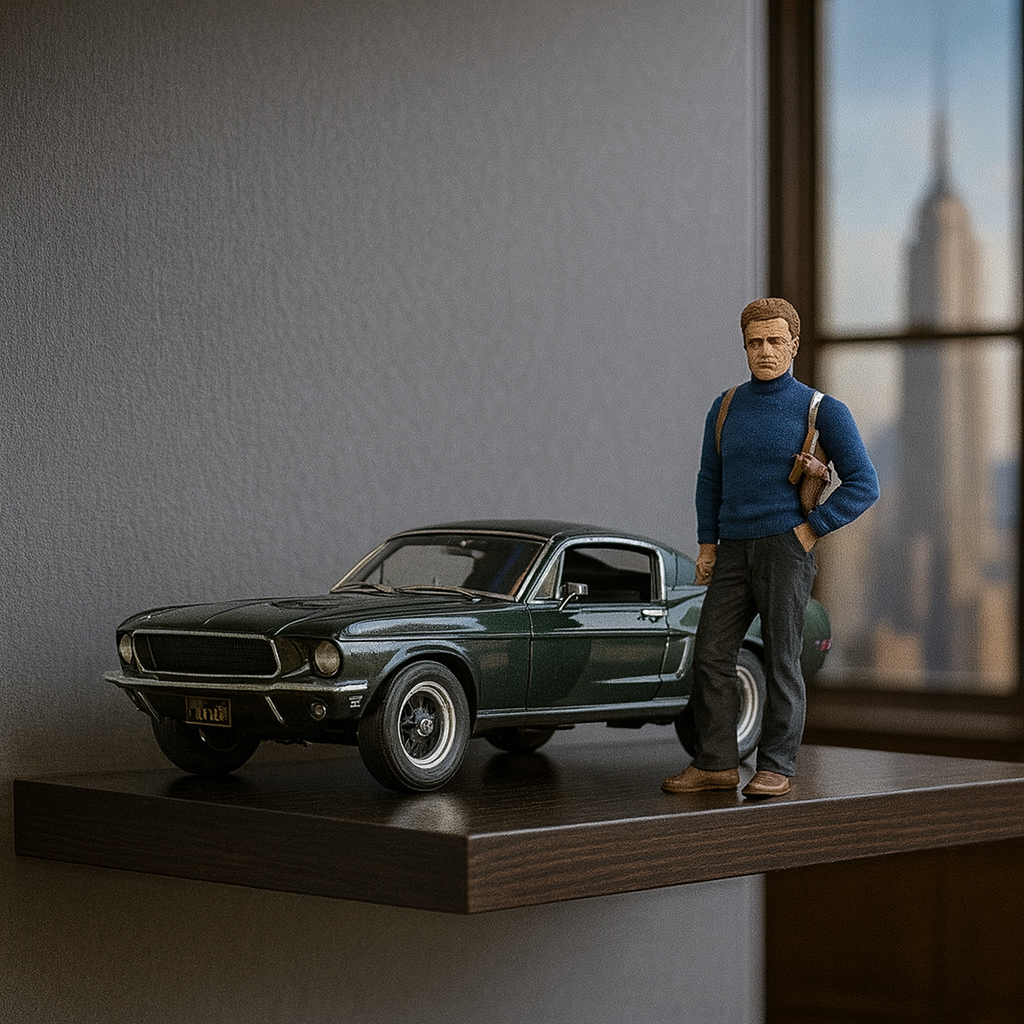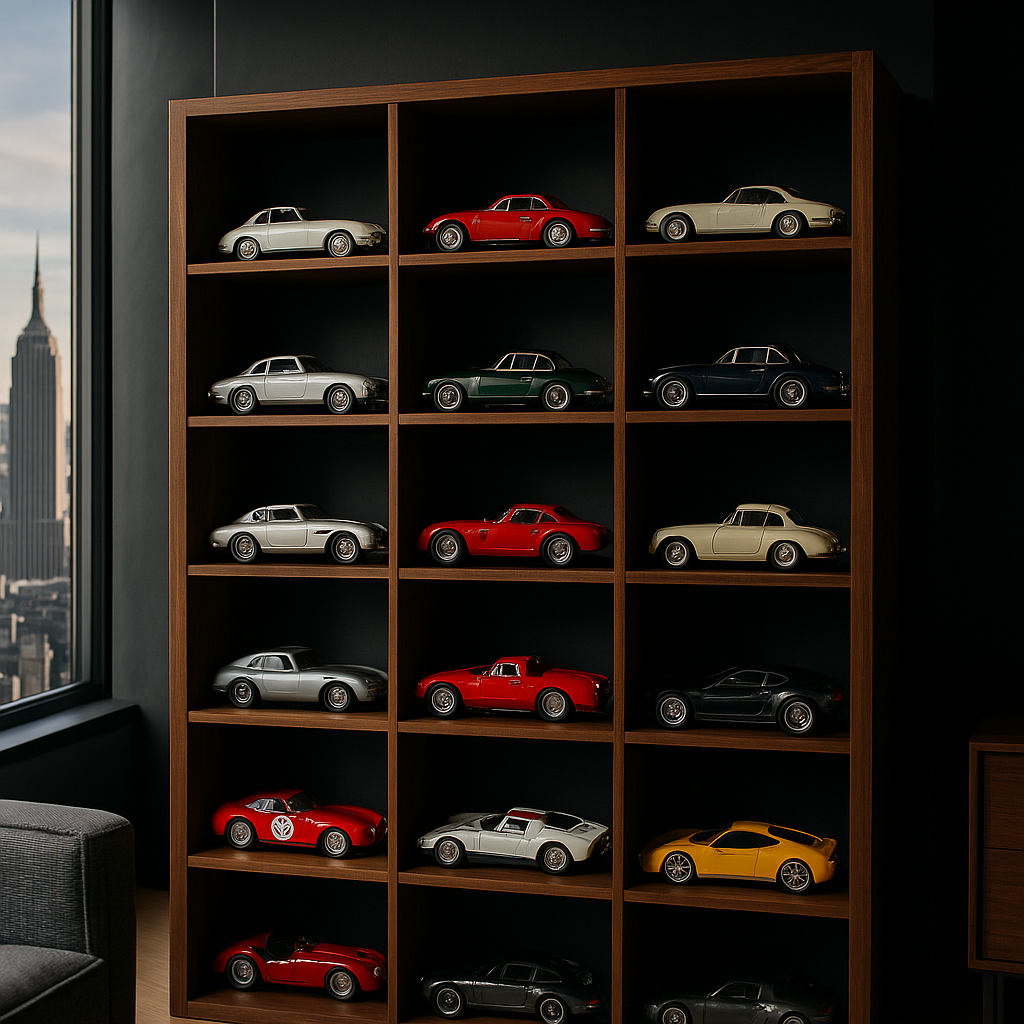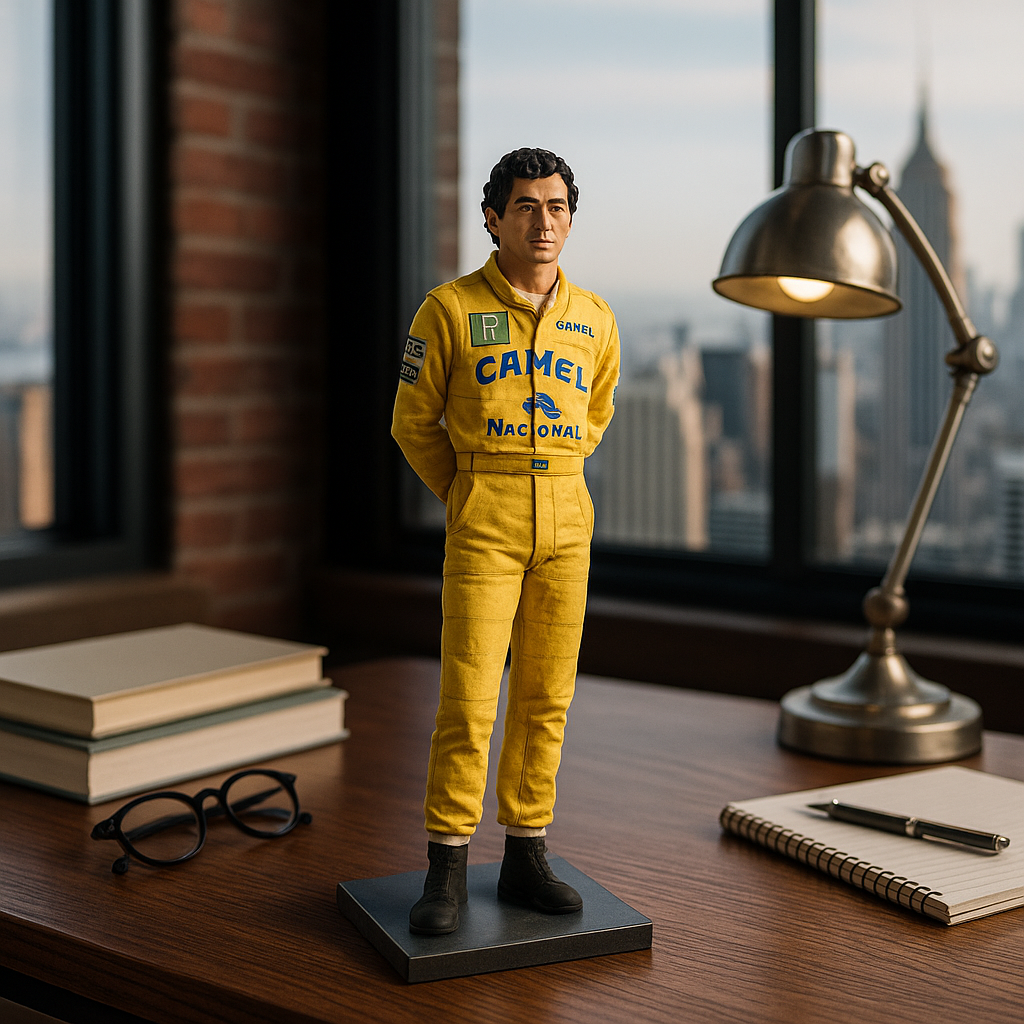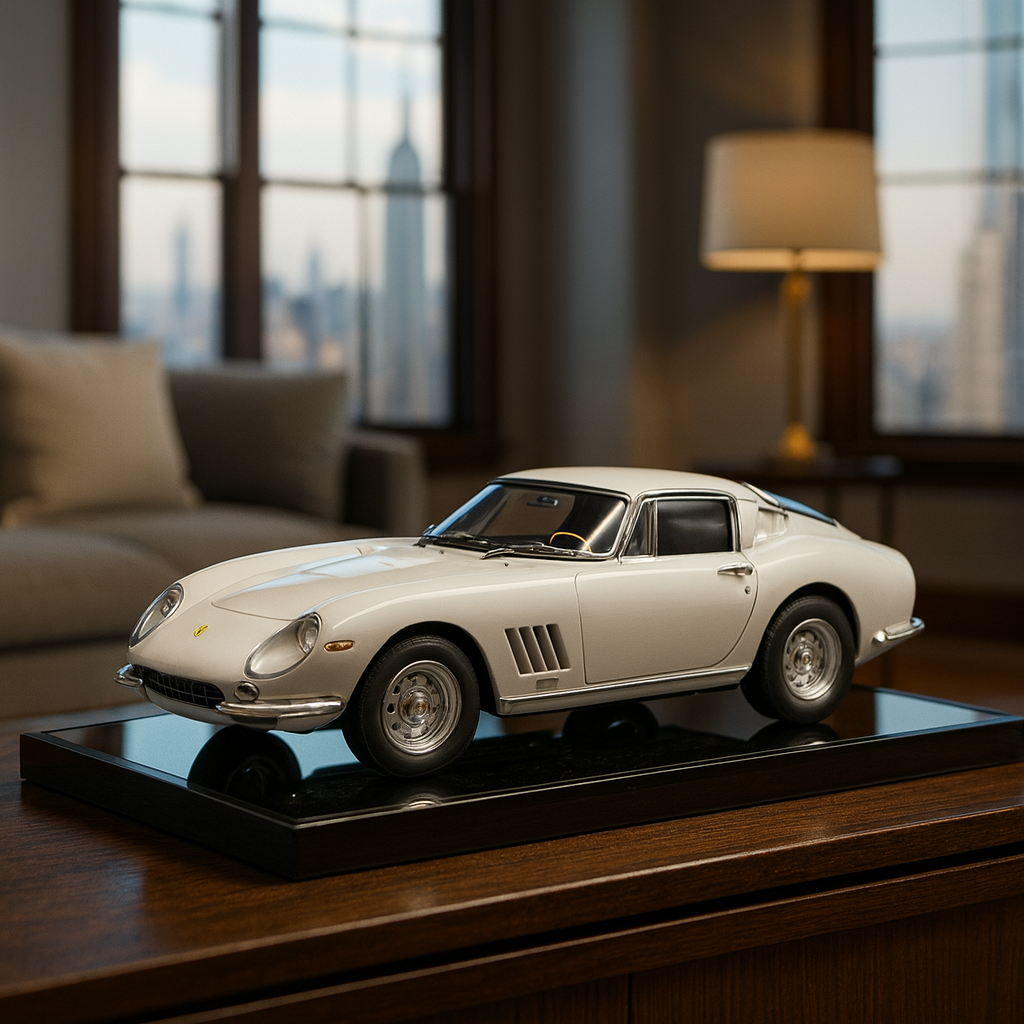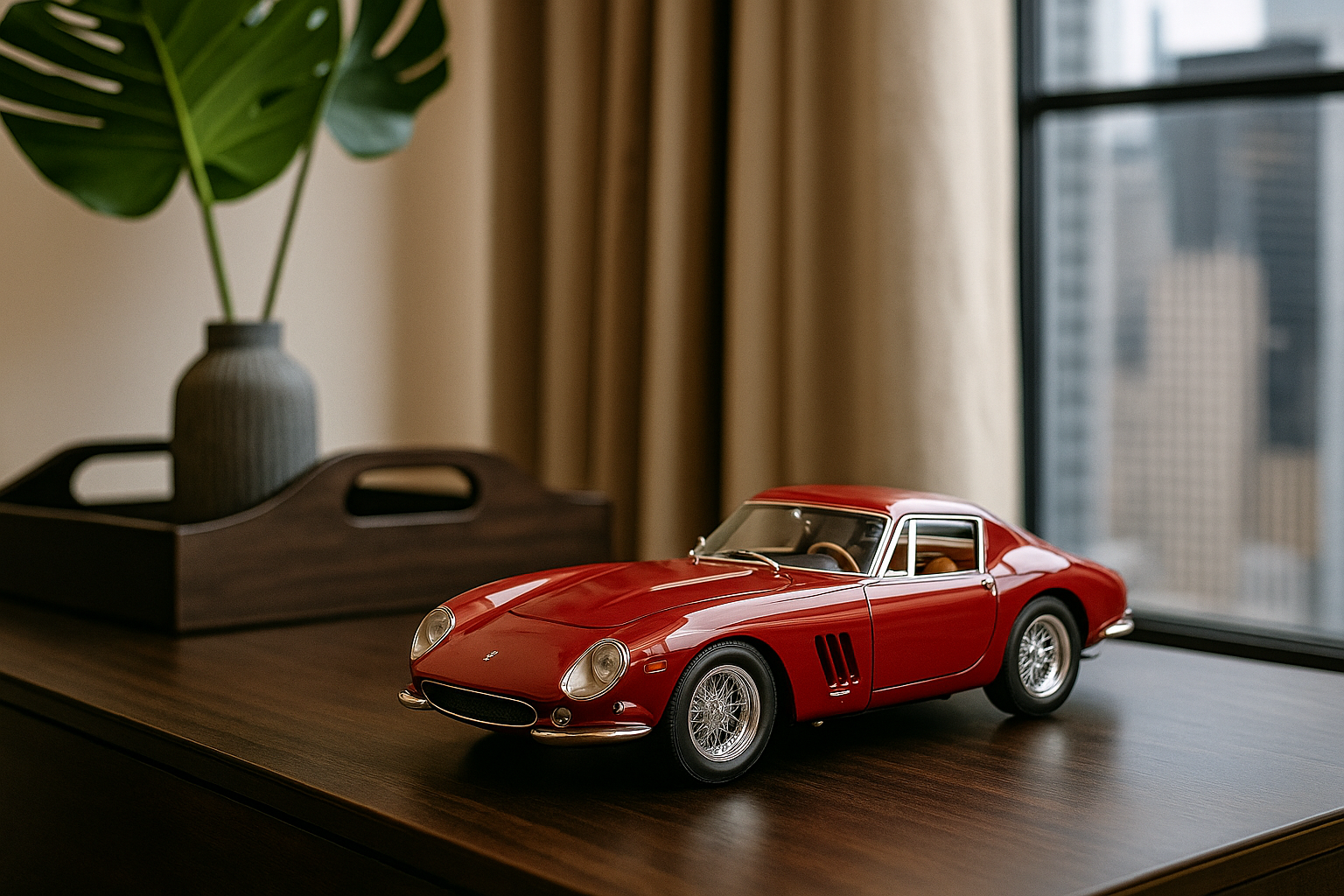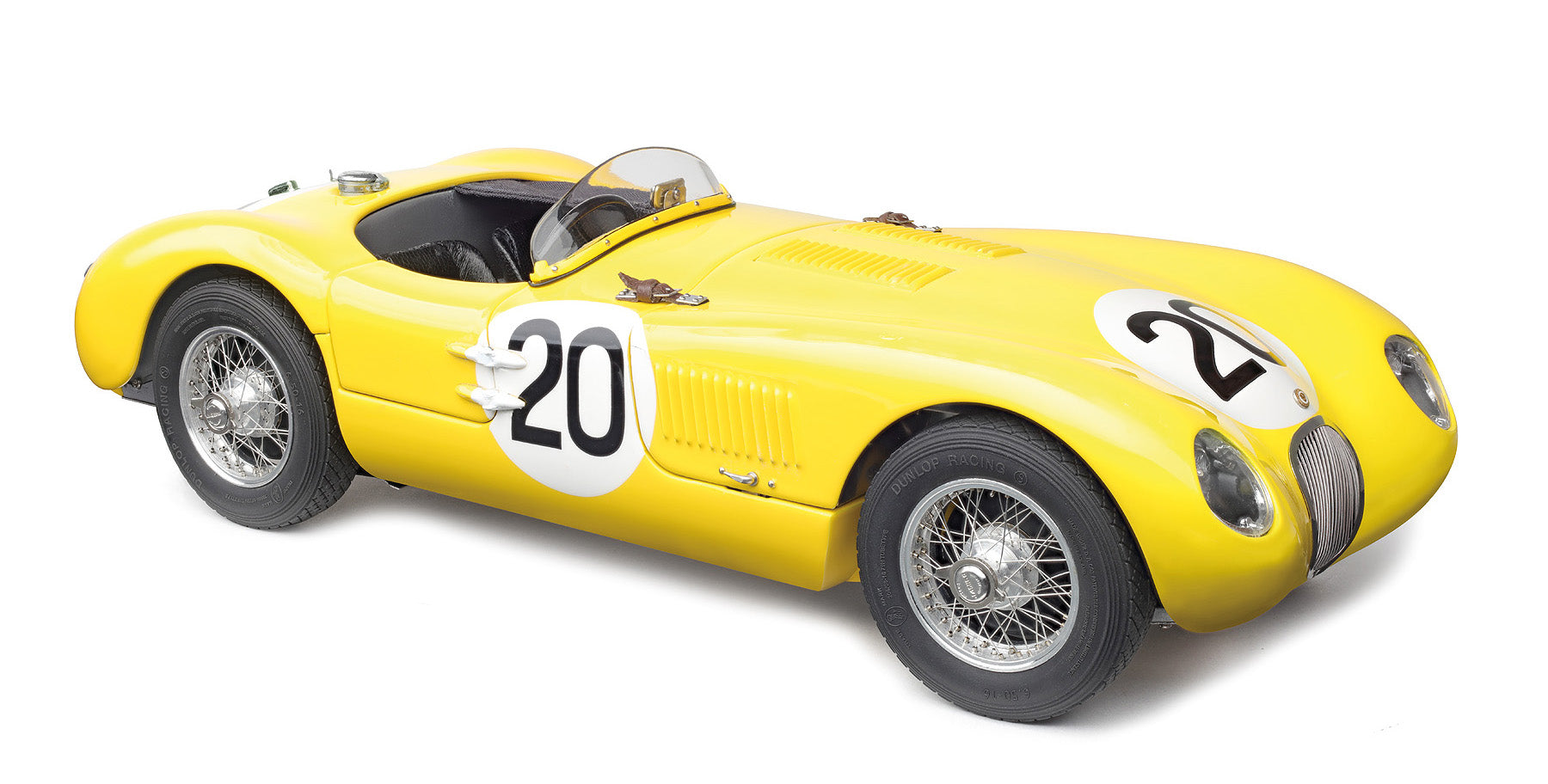
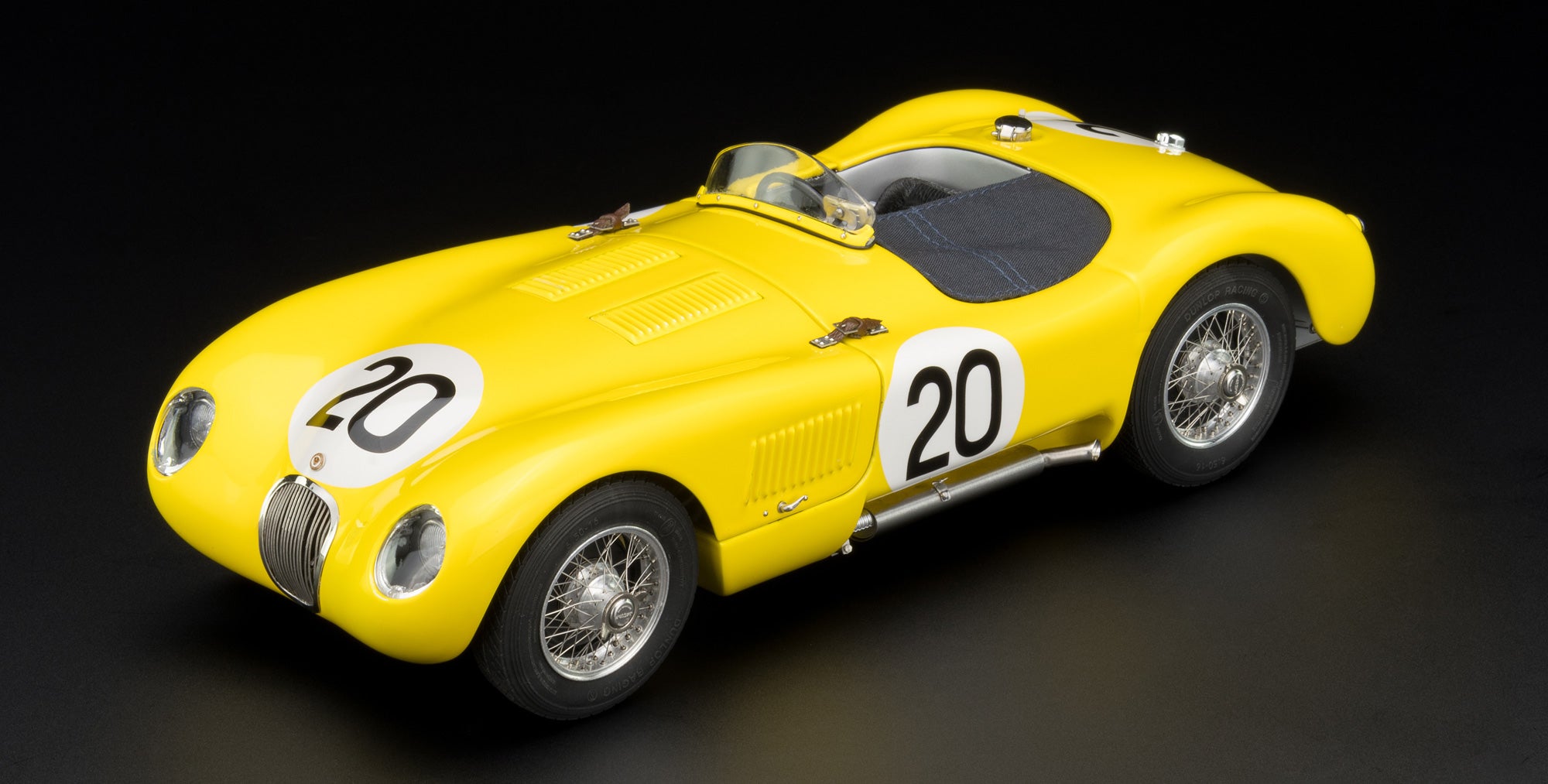
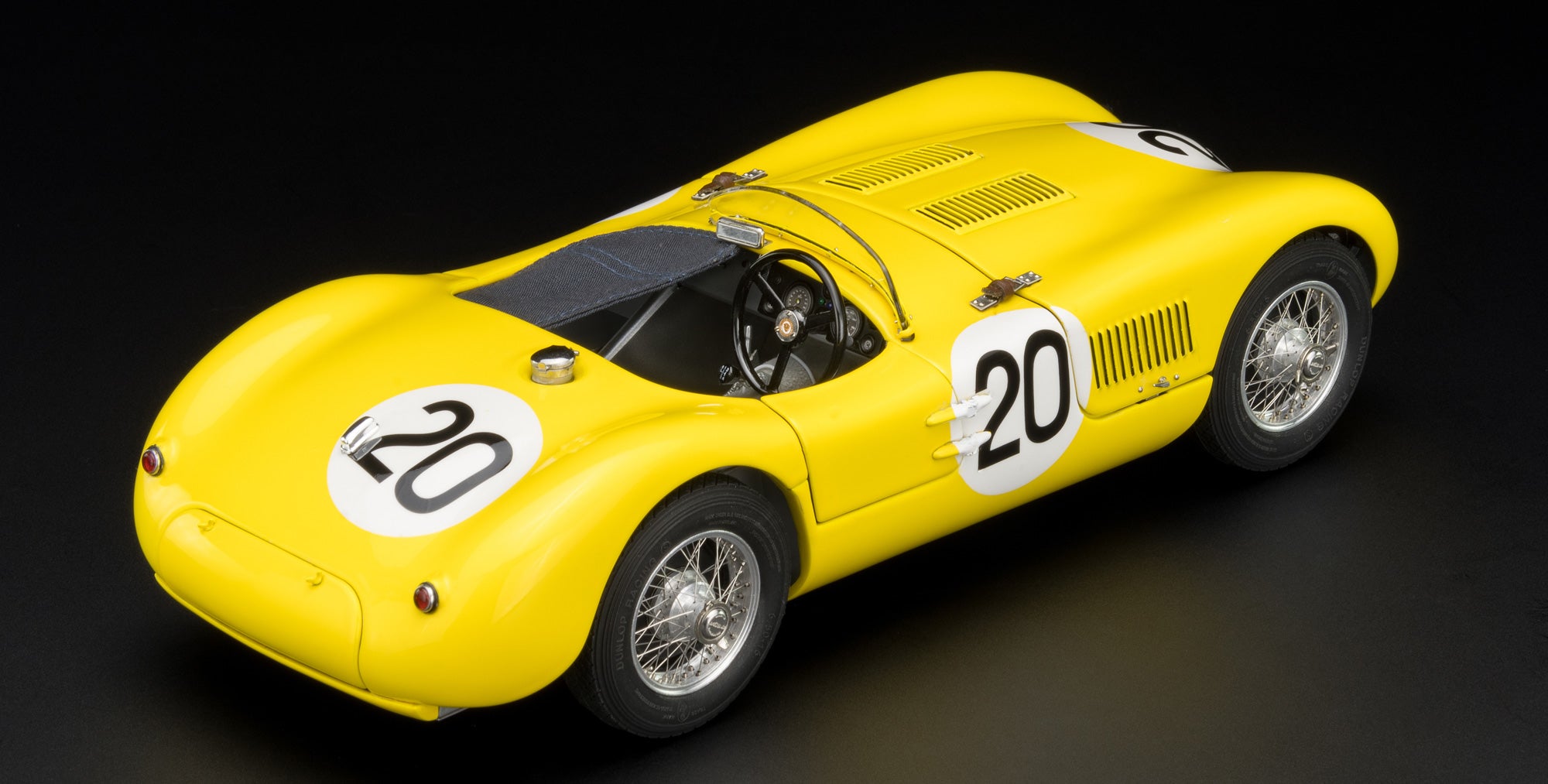
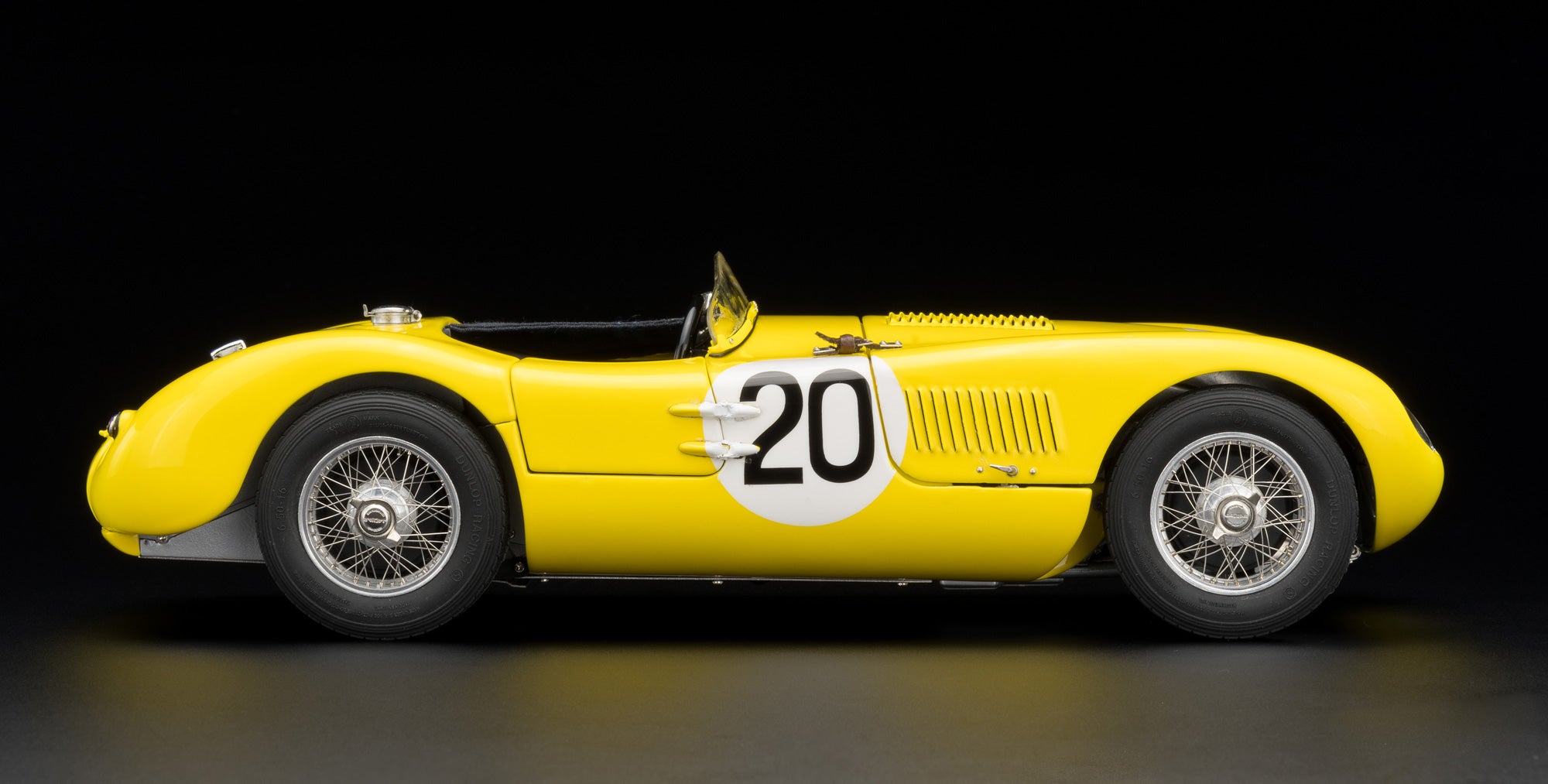
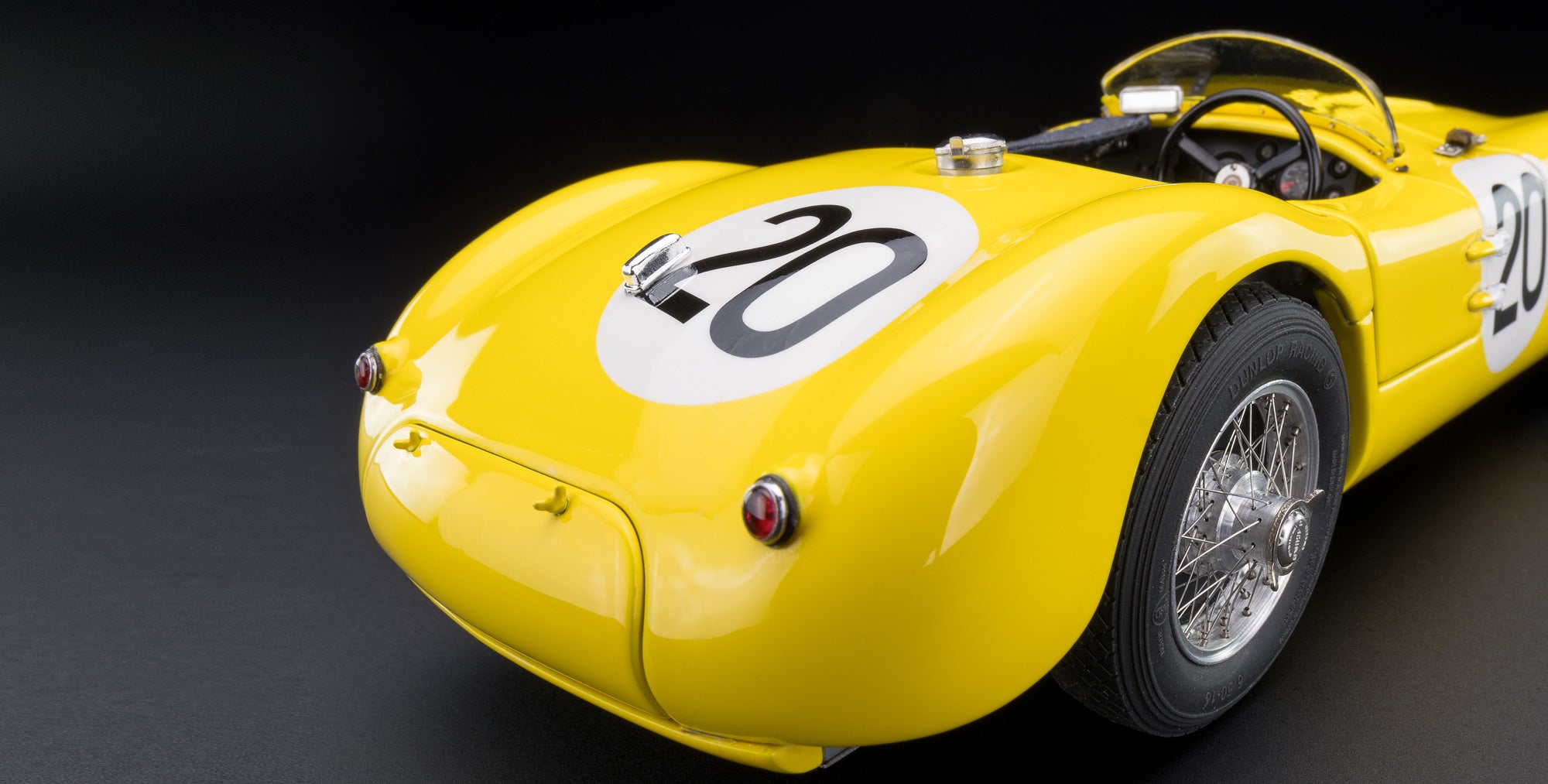
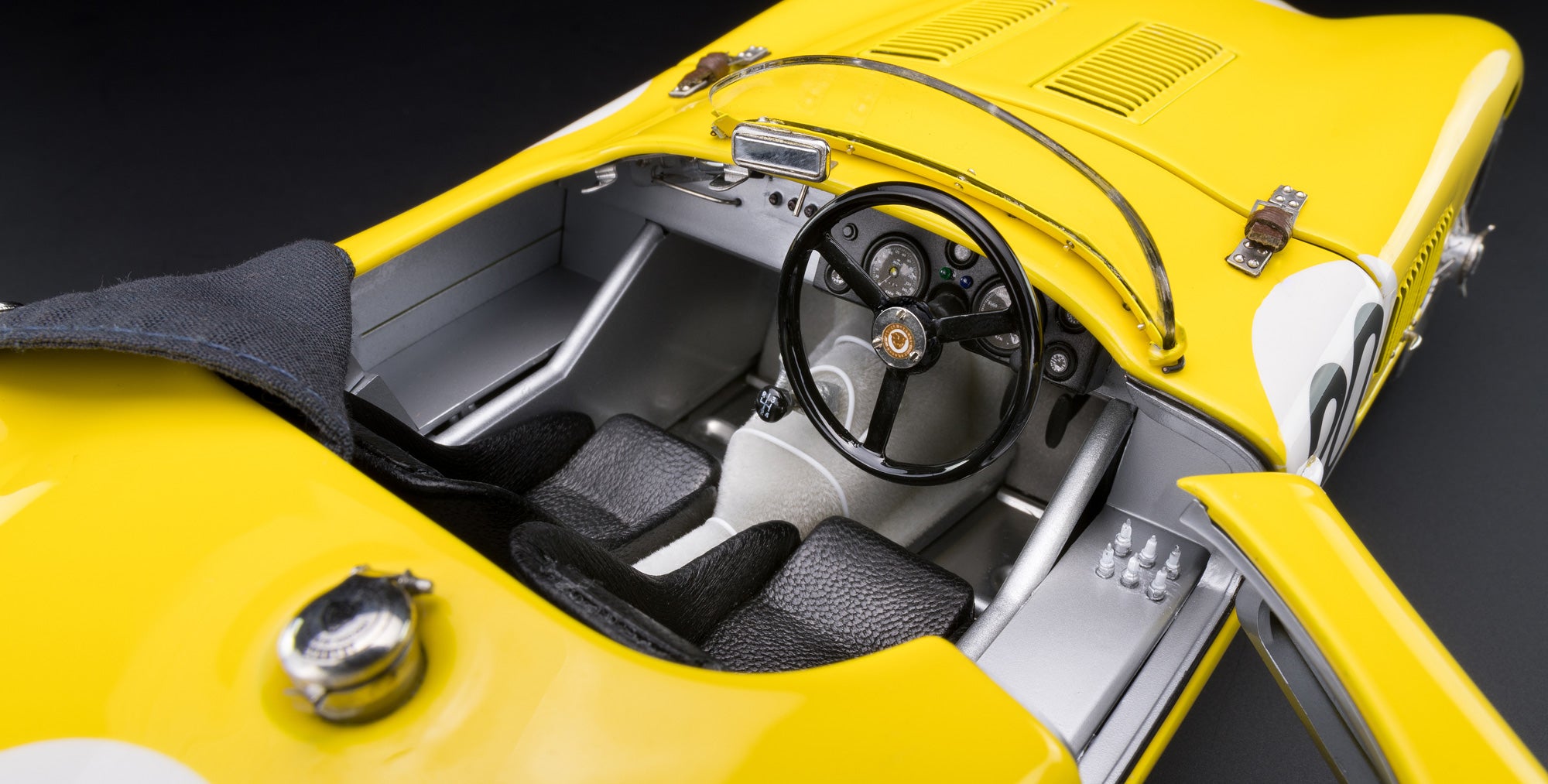
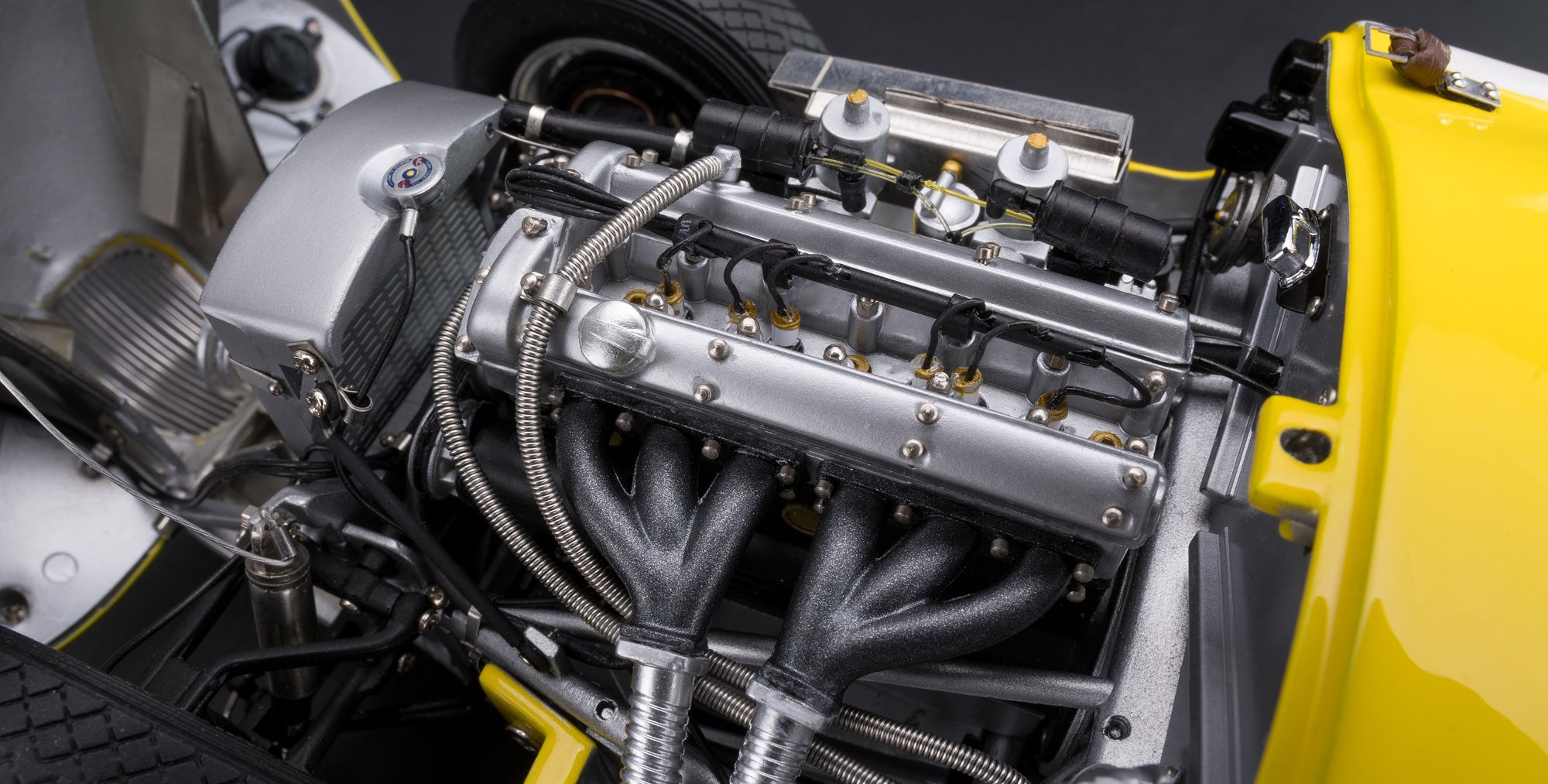
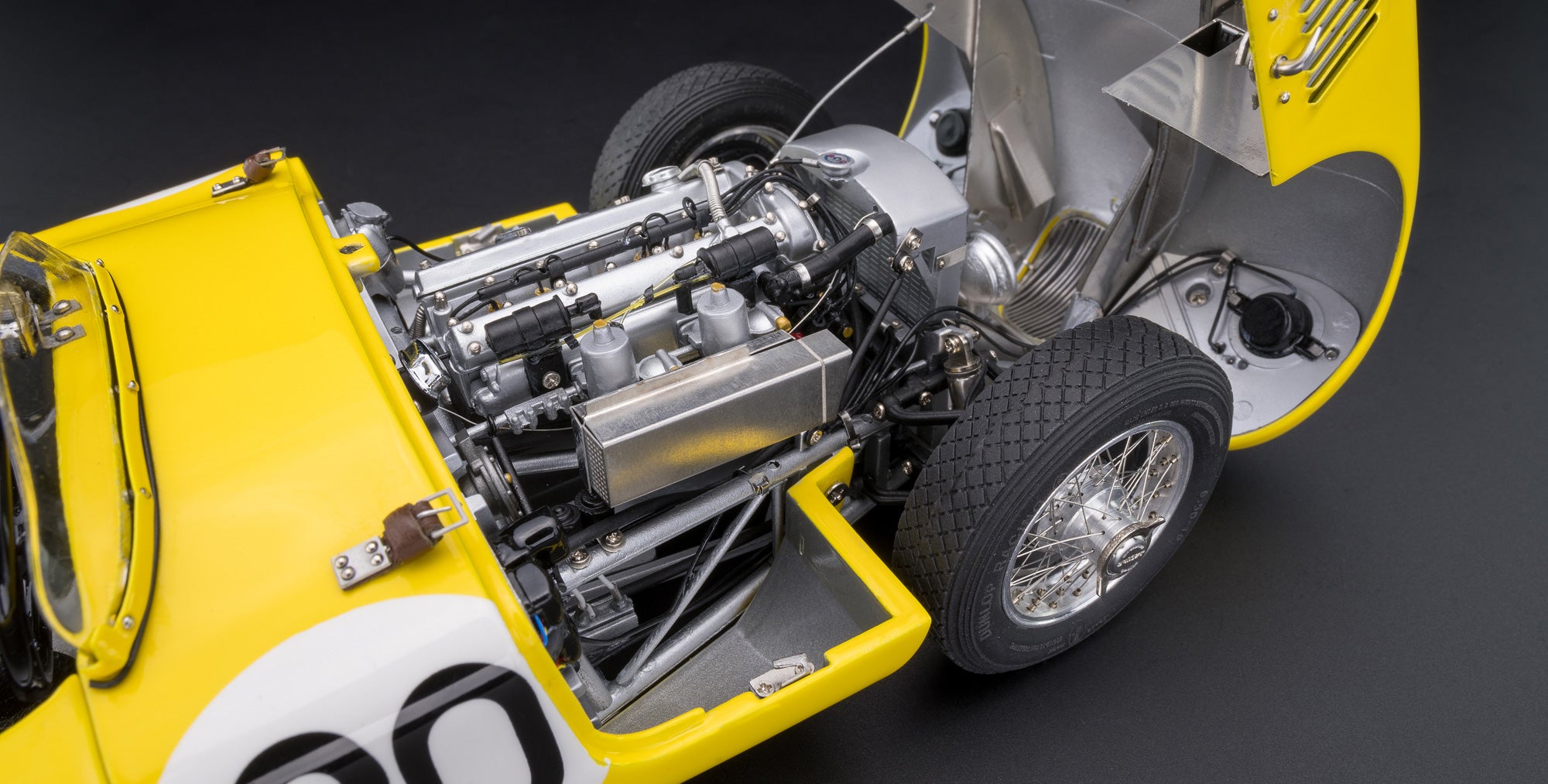
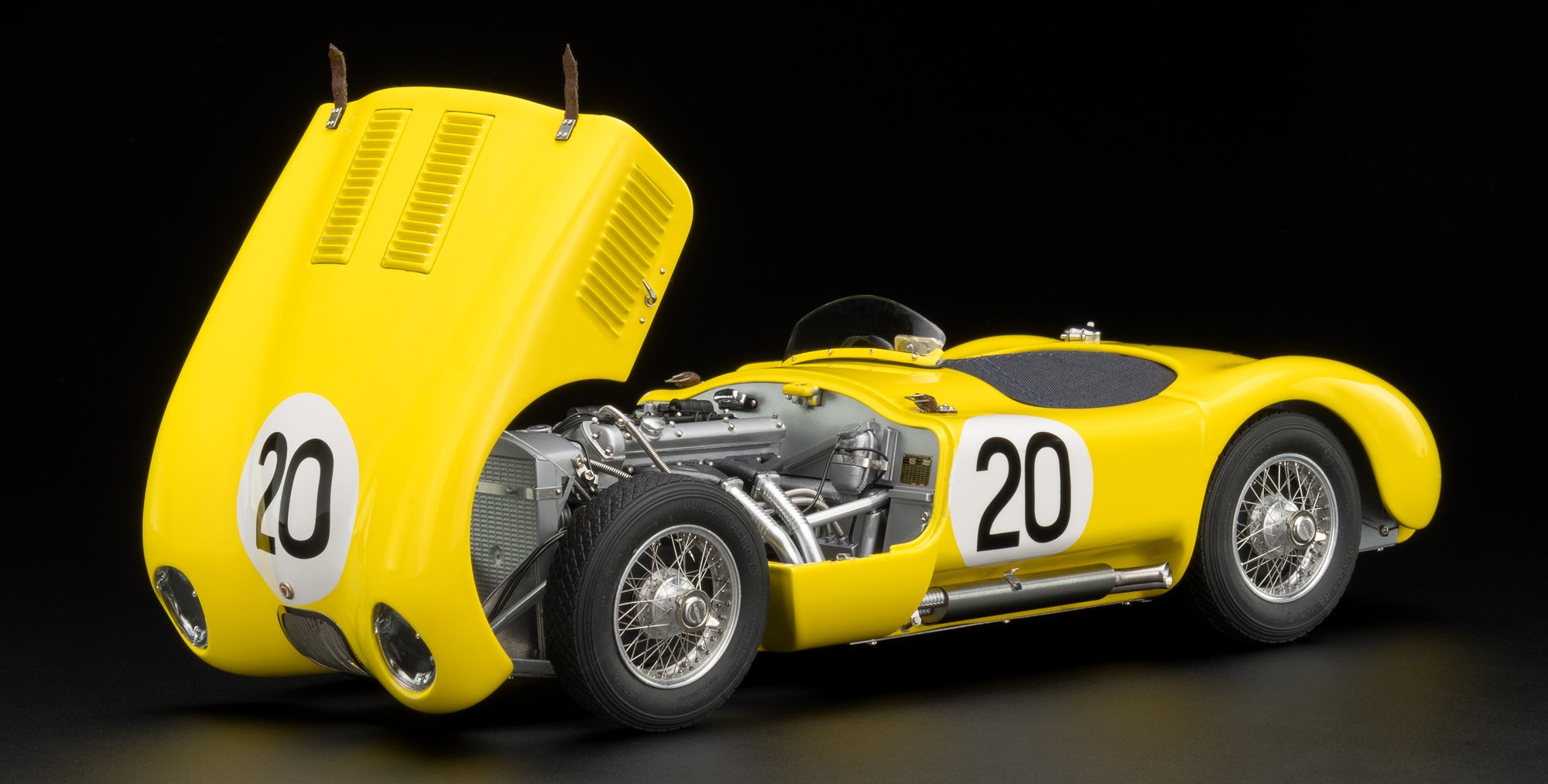
Jaguar C-Type #20 24h Le Mans 1953 Laurent/de Tornaco CMC M-194 LE 1,000

Description
Roger Laurent, Charles de Tornaco #20, Ecurie Francorchamps
Limited Edition 1000 pieces
The endurance classic was Jaguar's primary goal from the start, as they were aware of the marketing impact of a win at Le Mans. As a backup for the three-car Jaguar factory team, the Ecurie Francorchamps, founded a year earlier, came to Le Mans and enjoyed the same factory support as the Lightweight C-Types. The result of the two drivers in the almost standard C-Type was impressive – de Tornaco and Laurent finished ninth overall. CMC therefore decided to develop this variant, which is both interesting in terms of both motorsport and color. The result is a miniature with impressive charisma and sporty dynamics.
The Ecurie Francorchamps was founded in 1952 by Jacques Swaters. The Belgian team took part in several Formula 1 races from 1952 to 1954, but the team's only victory with racing team owner Swaters at the wheel was the 1953 Avus race, a non-World Championship Grand Prix. The Ecurie Francorchamps competed in sports car races with Ferrari vehicles until 1978. But its origins can be found with Jaguar. The Belgian team took part in Le Mans in 1953 as part of the Jaguar works effort. Jaguar boss Lyons was impressed by the team's ninth place overall and sent the Belgians to Spa and the Nürburgring for the remaining races of the season. The Belgian racing team competed again in the 24 Hours of Spa in July with Laurent and team owner Swaters, but retired due to engine failure. The team's deployment in the Eifel at the end of August also remained unsuccessful – again, it was engine failure that led to the vehicle's retirement.
XKC047 then returned to Jaguar Cars Ltd. in Coventry, where it received a new engine with a Weber carburetor system and the revised rear axle of the Lightweight models. The C-Type was subsequently handed over to the Ecurie Francorchamps Dunlop as a test vehicle. XKC047 remained in racing use until 1959, and from 1963 onward, it remained in the possession of a single family for more than half a century. This C-Type was the foundation stone of Guy Griffith's not-insignificant collection in southern England. In 2016, the C-Type was sold at a Bonham's auction in Monaco for €7.2 million – unrestored and 100% original.
Last but not least: the Ecurie Francorchamps competed again in the 1954 season with a C-Type (XKC011) newly built by Jaguar, also with a Weber carburettor system, and was again successful: fourth place overall at Le Mans 1954, third place at the 12 Hours of Reims and seventh place at the legendary Tourist Trophy.
Model description:
- Metal precision model made of more than 1,162 parts, hand-assembled
- Hinged and lockable bonnet
- True-to-original replica of the six-cylinder in-line engine with all add-on units and complete wiring/cabling
- Metal exhaust pipes
- Metal wishbone front axle with oil-pressure shock absorbers
- Torsion bar suspension in longitudinal arrangement
- Rigid rear axle with trailing arms and oil-pressure shock absorbers made of metal
- Torsion bar suspension in transverse arrangement
- Handcrafted, painted stainless steel grille
- Detailed replica of the cooling system
- Detailed laying of oil and fuel lines
- Movable tank cap
- Driver's door with authentically reproduced hinges for opening
- Cockpit with leather-covered driver and passenger seats
- Perfectly designed spoked wheels with hand-drawn and nippled stainless steel wire spokes
- Screwable wheel center locks with right/left thread
- Brilliant paintwork in original color
- Positioning of start number 20 using pad printing
Technical data of the original vehicle:
- Racing car built on a tubular space frame
- Body made of thin aluminum sheet
- Six-cylinder in-line engine with 3.4 litres displacement
- 2 valves per cylinder, controlled by two overhead camshafts
- Dry sump lubrication
- Mixture preparation with two SU downdraft carburettors type H8/9
- Ignition with coil and capacitor, one spark plug per cylinder
- Four-speed gearbox flanged to the engine
| Perfomance: | 200 hp at 5,800 rpm |
| Engine capacity: | 3,442 cc |
| Bore x stroke | 83 x 106 mm |
| Top speed: | 230 km/h (depending on rear axle ratio) |
| Wheelbase: | 2,438 mm |
| Total length: | 3,988 mm |
| Total width: | 1,638 mm |
| Track width front/rear | 1,295 / 1,295 mm |
| Total height: | 981 mm |
| Empty weight | 970 kg (2102 lb.) |
CMC Legal Disclaimer
The use of racing team and/or driver names, symbols, starting numbers, and/or descriptions is solely for reference purposes. Unless otherwise stated, it does not imply that the CMC scale model is a product of any of these racing teams/drivers or endorsed by any of them.
Notice
Roger Laurent, Charles de Tornaco #20, Ecurie Francorchamps
Limited Edition 1000 pieces
The endurance classic was Jaguar's primary goal from the start, as they were aware of the marketing impact of a win at Le Mans. As a backup for the three-car Jaguar factory team, the Ecurie Francorchamps, founded a year earlier, came to Le Mans and enjoyed the same factory support as the Lightweight C-Types. The result of the two drivers in the almost standard C-Type was impressive – de Tornaco and Laurent finished ninth overall. CMC therefore decided to develop this variant, which is both interesting in terms of both motorsport and color. The result is a miniature with impressive charisma and sporty dynamics.
The Ecurie Francorchamps was founded in 1952 by Jacques Swaters. The Belgian team took part in several Formula 1 races from 1952 to 1954, but the team's only victory with racing team owner Swaters at the wheel was the 1953 Avus race, a non-World Championship Grand Prix. The Ecurie Francorchamps competed in sports car races with Ferrari vehicles until 1978. But its origins can be found with Jaguar. The Belgian team took part in Le Mans in 1953 as part of the Jaguar works effort. Jaguar boss Lyons was impressed by the team's ninth place overall and sent the Belgians to Spa and the Nürburgring for the remaining races of the season. The Belgian racing team competed again in the 24 Hours of Spa in July with Laurent and team owner Swaters, but retired due to engine failure. The team's deployment in the Eifel at the end of August also remained unsuccessful – again, it was engine failure that led to the vehicle's retirement.
XKC047 then returned to Jaguar Cars Ltd. in Coventry, where it received a new engine with a Weber carburetor system and the revised rear axle of the Lightweight models. The C-Type was subsequently handed over to the Ecurie Francorchamps Dunlop as a test vehicle. XKC047 remained in racing use until 1959, and from 1963 onward, it remained in the possession of a single family for more than half a century. This C-Type was the foundation stone of Guy Griffith's not-insignificant collection in southern England. In 2016, the C-Type was sold at a Bonham's auction in Monaco for €7.2 million – unrestored and 100% original.
Last but not least: the Ecurie Francorchamps competed again in the 1954 season with a C-Type (XKC011) newly built by Jaguar, also with a Weber carburettor system, and was again successful: fourth place overall at Le Mans 1954, third place at the 12 Hours of Reims and seventh place at the legendary Tourist Trophy.
Model description:
- Metal precision model made of more than 1,162 parts, hand-assembled
- Hinged and lockable bonnet
- True-to-original replica of the six-cylinder in-line engine with all add-on units and complete wiring/cabling
- Metal exhaust pipes
- Metal wishbone front axle with oil-pressure shock absorbers
- Torsion bar suspension in longitudinal arrangement
- Rigid rear axle with trailing arms and oil-pressure shock absorbers made of metal
- Torsion bar suspension in transverse arrangement
- Handcrafted, painted stainless steel grille
- Detailed replica of the cooling system
- Detailed laying of oil and fuel lines
- Movable tank cap
- Driver's door with authentically reproduced hinges for opening
- Cockpit with leather-covered driver and passenger seats
- Perfectly designed spoked wheels with hand-drawn and nippled stainless steel wire spokes
- Screwable wheel center locks with right/left thread
- Brilliant paintwork in original color
- Positioning of start number 20 using pad printing
Technical data of the original vehicle:
- Racing car built on a tubular space frame
- Body made of thin aluminum sheet
- Six-cylinder in-line engine with 3.4 litres displacement
- 2 valves per cylinder, controlled by two overhead camshafts
- Dry sump lubrication
- Mixture preparation with two SU downdraft carburettors type H8/9
- Ignition with coil and capacitor, one spark plug per cylinder
- Four-speed gearbox flanged to the engine
| Perfomance: | 200 hp at 5,800 rpm |
| Engine capacity: | 3,442 cc |
| Bore x stroke | 83 x 106 mm |
| Top speed: | 230 km/h (depending on rear axle ratio) |
| Wheelbase: | 2,438 mm |
| Total length: | 3,988 mm |
| Total width: | 1,638 mm |
| Track width front/rear | 1,295 / 1,295 mm |
| Total height: | 981 mm |
| Empty weight | 970 kg (2102 lb.) |
CMC Legal Disclaimer
The use of racing team and/or driver names, symbols, starting numbers, and/or descriptions is solely for reference purposes. Unless otherwise stated, it does not imply that the CMC scale model is a product of any of these racing teams/drivers or endorsed by any of them.


